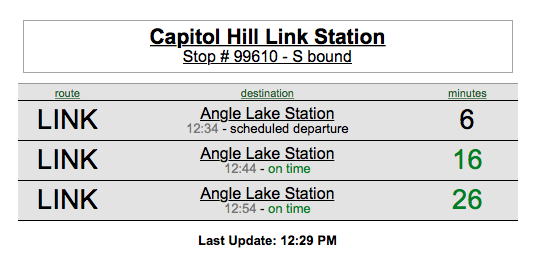Link Real-Time Arrival Now on OneBusAway

Link at Othello - SounderBruce (Flickr)
In welcome news for riders, Sound Transit (ST) announced this morning that real-time arrival information for Link is now available on OneBusAway, Transit, Google, and other 3rd-party apps. As we reported last month, the update is limited to riders' personal devices, as no new real-time signage will be available on station platforms for the foreseeable future. Originally planned for "early 2014", the update finally responds in part to long-standing frustration at lack of rider information on what should be the region's premier transit product. For SeaTac, Tukwila, Rainier Valley, Becaon Hill, and Downtown riders, this is the first type of real-time arrival they will have ever enjoyed.

So why has it taken so long? Beyond customary bureaucratic delay and budgetary prioritization, the central problem has been technological conflicts between ST's internal-facing Supervisory Control and Data Acquisition (SCADA) system and the very different demands of user-facing applications and 3rd-party accessible data.
Problems with merely reporting SCADA data are evident to anyone looking at the real-time signs in Capitol Hill and UW Stations. SCADA tracks Link trains in between-station segments rather than continuously along the line, leading to a "step function" type of predictive ability. If you're standing southbound at Capitol Hill, for instance, the next train may disappear from the screen right before it enters service, leading to signs saying "10, 16, 22" minutes etc even though the next train is only 4 minutes away. Once the train leaves UW, the "4 minute" train abruptly returns, dropping quickly to 2 minutes right before arrival. And the visual display may often conflict with the audio announcements of "2 minutes", because the audio message gets put into the queue at a lower priority than other announcements such as elevator/escalator outages.
ST says the data will be most accurate in the middle of the line, in the Rainier Valley, where operations are most consistent. Beyond the terminal problems described above - which will endure southbound at Capitol Hill and now northbound at SeaTac Airport - other operational quirks will occasionally produce data gaps. If you're standing northbound at International District station just before the start of PM peak, for instance, the train you're waiting for may be coming from the Sodo base instead of from Angle Lake, but it will show as "scheduled" until it's actually active on the line.
There will still be small discrepancies between OneBusAway, the visual screens, and the audio announcements - they have different rounding rules, for instance - but they should all be within a minute of each other. Real-time data will be especially useful for showing train delays and bunching, something that has been blind to riders since Link launched in 2009.
A universal real-time arrival design and implementation will have to wait a few more years, likely until Sound Transit owns and operates a Link-only Downtown Seattle Transit Tunnel beginning in or around 2019. But with wifi and/or cell service in all underground stations by the end of this year, underground riders will no longer face an information vacuum, and all riders with smartphones can know when their next train will arrive. This is a big, if belated, step in the right direction.